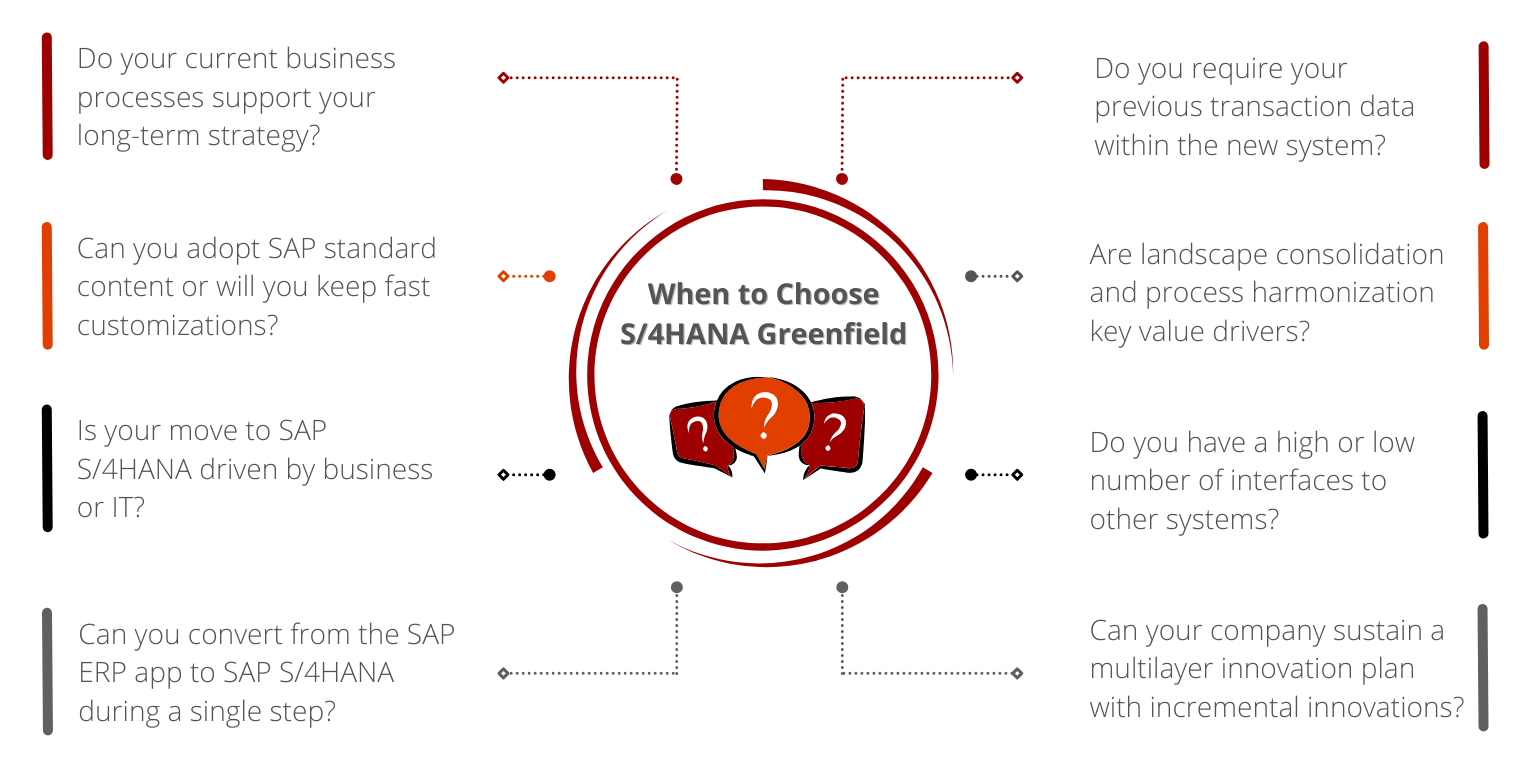What is SAP S/4HANA Greenfield Approach | New implementation

Hello and welcome!
Curious about how to kickstart your digital transformation?
The first-come thought of any SAP perceiving firm during its digital transformation journey is to choose the best path for transformation. Whether a new SAP client or an existing SAP customer, everyone needs proper guidelines for their digital transformation.
Especially, ever since SAP has announced its suspension of providing services for the earlier versions of SAP systems like SAP ECC 6.0, most SAP clients have started to look upon their paths to adopt digital transformation with SAP.
This writing focuses to deliver clarity on why, when, and how to sculpt your SAP S/4HANA implementation journey. To begin with let’s look at the SAP S/4HANA Greenfield implementation (New Implementation).
What is the SAP S/4HANA Greenfield Approach?
The S/4HANA Greenfield approach refers to a fresh start “on a greenfield location” in metaphorical meaning. Greenfield is a phrase that originated in urban planning and is now used in software development. Existing IT systems or individual advancements are not required to be considered in this approach.
In IT, processes and systems are entirely reinstalled and changed when SAP S/4HANA is reimplemented in accordance with SAP standards and best practices. This is akin to a corporation that is using ERP software for the first time.
In such circumstances, current business processes and data are reviewed and optimized first to prepare for your migration to the new ERP software. The master data is moved into SAP HANA and the users are educated after the S/4HANA system is set up for operation. Then the go-live is then performed.
When to Choose the S/4HANA Greenfield Approach?
Because you are not the only company in the business embracing digital transformation, there is a high probability that your SAP ECC rivals have already begun the upgrade process. As a result, getting ahead of the limitations, locating an ERP testing service provider, and aiming for something new may help you perform better.
We offer you these eight keys to decide the path of your transformation journey.
Eight Keys to Consider

1. Do your current business processes support your long-term strategy?
If there is a requirement to redesign your long-term business strategy, NEW IMPLEMENTATION is preferable. It also encompasses historically grown firms handling enormous and complicated data.
2. Can you adopt SAP standard content (SAP Best Practices), or will you keep fast customizations?
If your business tends to possess extensive usage of SAP’s Best Practices, new implementations are going to be a far better choice. In turn, if your self-tailored enhancements and modifications appear to be your prime asset, then system conversion would be the choice.
3. Is your move to SAP S/4HANA driven by business or IT?
Starting a business transformation from an IT project is nearly difficult. IT-sponsored initiatives are often system transformations that serve as the motivation for later business-driven innovation projects.
4. Can you convert from the SAP ERP application to SAP S/4HANA during a single step?
User systems with SAP ERP 6.0 single-stack, Unicode systems; supports single-step conversion despite a couple of OS-level restrictions. If a single-step conversion is technically not feasible, choosing a new implementation is advised. Because combining two upgrades during a single maintenance window will exceed the extent of system outage your business can afford.
The next consideration factor is your rollout strategy. If your rollout relies on company-code-by-company-code, then the new implementation approach is preferred.
The implied cost of integrating the old and new system landscapes for intercompany scenarios and the constraints to be considered are master data synchronization and consolidation.
5. Do you require your previous transaction data within the new system?
The requirement in taking care of the prevailing data within the system points towards choosing System Conversion.
6. Are landscape consolidation and process harmonization key value drivers?
For companies with a history of mergers and acquisitions, it’s difficult for various divisions to accept an impartial set of SAP best practices.
7. Do you have a high or low number of interfaces to other systems?
Third-party solutions with interfaces have to be redeveloped and tested in case of the new implementation.
8. Can your company sustain a multilayer innovation plan with incremental innovations?
Formulating incremental innovation as a part of your company’s philosophy, then select System conversion in your upgrade. If your company does not judge to be efficient enough to execute a multi-year plan, consistently choose new implementation to experience the entire value of SAP S/4HANA.
The above keys navigate you towards either System Conversion or New Implementation. Make sure you understand your requirements and answer these questions with enough clarity.
How to approach SAP S/4HANA Implementation?
Because the first step of S/4HANA transformation is the path to deliverables, it is critical to perform the business conversion while gathering information on SAP HANA migration, features, cost, and time. The below are the critical phases of SAP S/4 HANA implementation’s first phase:
-
Business Readiness Check
This phase demands the preparation of a standard readiness report, which is processed after a study of the implementation’s technical and business components. Furthermore, the ERP testing company uses the information to decide the implementation plan.
-
Business Requirement Check
The second step is compiling a list of all the modifications that must be made to the current ERP system. Furthermore, the second stage is concerned with the execution cycle, establishing the critical path to S/4 HANA installation while resolving the development environment’s suitability for the existing process.
-
Verifying ABAP Code
The ABAP code must be checked for conformance with SAP HANA standards in the third phase of the process. This will necessitate a value of SQL queries in ABAP projects based on the current requirements. The procedure also requires determining the arrangement of improvements that must be used to ensure accuracy in data collection within the time frame.
-
Environment Architecture
Finally, the data acquired for assessing the readiness of the implementation process and all IT requirement analysis information is used to evaluate the accessible framework. During this stage, developers must work on target climate design while collaborating with the Equipment Service Provider. Altogether, this process results in the development of the actual or final environment architecture, which includes hardware, an os, and a LAN.

Final thoughts & answering the “WHY?”
Greenfield implementation is a long-term strategy for implementing new offerings that can help businesses achieve a competitive edge. Some of the primary advantages of greenfield implementation include:
- A new and improved business method
- Aids in the development of a competitive advantage
- Overall business transformation
- Support Acquisition Capability and Strategy
- Cost Reduction & Flexibility
- Streamlined Processes & Workflows
Conclusion
We understand that migrating to SAP S/4HANA is a significant decision given the ramifications for your organization. With over 17+ years of experience, 800+ specialized consultants, and 70+ SAP S/4HANA transformations, KaarTech offers the expertise you need for a successful transition.
If you want to learn more about our customer success stories or discuss incorporating S/4HANA into your business model with a value-added partner through SAP consultancy, feel free to contact us at KaarTech.
FAQ’s
1. What is the S/4HANA Greenfield approach?
The Greenfield approach is a fresh start with SAP S/4HANA, implementing new systems and processes from scratch, without considering existing IT systems.
2. When should a company choose the Greenfield approach?
Opt for Greenfield if you need a complete overhaul of processes, have complex data, or if a single-step conversion is not feasible.
3. What are the key considerations for Greenfield implementation?
Consider your business strategy alignment, need for SAP Best Practices, data migration needs, and ability to support incremental innovations.
4. What are the benefits of a Greenfield implementation?
Benefits include streamlined processes, improved business methods, cost reduction, flexibility, and the development of a competitive edge.
